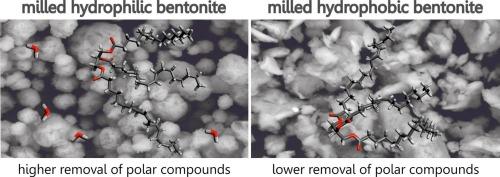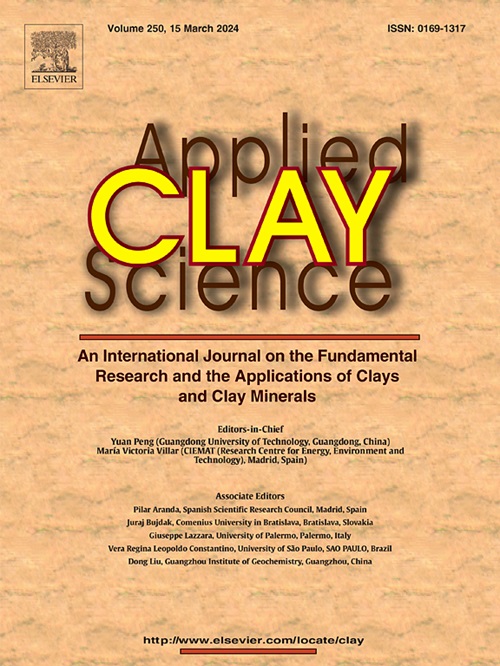亲水膨润土和疏水膨润土的形态对提高废食用油回收利用倾点的影响
IF 5.3
2区 地球科学
Q2 CHEMISTRY, PHYSICAL
引用次数: 0
摘要
世界各地的工业食品加工和家庭使用都会产生废食用油(WCOs),这些废食用油在处理时会引起环境问题。在植物油精炼过程中,膨润土经常被证明能有效去除少量污染物。本研究的重点是使用四种膨润土(两种商品膨润土和两种通过球磨最新获得的膨润土)加工未加工的 WCO。通过 X 射线衍射(XRD)、透射电子显微镜(TEM)、扫描电子显微镜(SEM)和 N2-透析吸附技术,对不同膨润土(疏水性和亲水性)在球磨(BM)过程前后的特性进行了详尽分析,包括晶体结构、形态和表面积。在 60 分钟内实现了研磨时间方面的 BM 处理优化。然后,将研磨后的粉末作为回收不同分解程度(以游离脂肪酸含量表示)的 WCO 的吸附剂进行了测试。采用实验设计方法,评估了五个参数(FFAs 含量、温度、比表面积、搅拌、BM 时间)对所得倾点 (PP) 的影响,倾点 (PP) 是再生油的质量基准。定量多元统计分析显示,温度的作用可以忽略不计,而膨润土的两个特性(比表面积和球磨时间)以及处理过程中的搅拌作用则具有重要影响。最后,亲水膨润土能够改善游离脂肪酸含量较低的废油(约 10 °C)的聚丙烯含量。本文章由计算机程序翻译,如有差异,请以英文原文为准。

Impact of morphology of hydrophilic and hydrophobic bentonites on improving the pour point in the recycling of waste cooking oils
Waste Cooking Oils (WCOs) are generated worldwide through industrial food processing and household use, posing environmental concerns upon disposal. Bentonites often showed to be effective in removing minor contaminants in vegetable oil refining. The present research focused on the processing of raw WCOs using four bentonites, two commercials and two obtained by ball milling of the latest. The different bentonites (hydrophobic and hydrophilic) were characterized before and after ball milling (BM) procedure, including an exhaustive analyses of crystal structure, morphology and surface area via x-ray diffraction (XRD), transmission electron microscopy (TEM), scanning electron microscopy (SEM), and N2-physisorption technique. Optimization of BM processing in terms of milling time was achieved within 60 min. The milled powders were then tested as adsorbents for recycling WCOs with different degrees of decomposition (expressed in terms of free fatty acids, FFAs, content). Employing a design of experiments approach, the impact of five parameters (FFAs content, temperature, specific surface area, stirring, BM time) on the resulting pour point (PP), taken as a quality benchmark for recycled oil, was assessed. Quantitative multivariate statistical analysis revealed temperature's negligible role and identified the significant impact of two characteristics of the bentonite (specific superficial area and ball milling time), as well as the relevant role of the stirring during the treatment. At the end, hydrophilic bentonite resulted able to improve the PP of waste oils with a low content of free fatty acids of about 10 °C.
求助全文
通过发布文献求助,成功后即可免费获取论文全文。
去求助
来源期刊

Applied Clay Science
地学-矿物学
CiteScore
10.30
自引率
10.70%
发文量
289
审稿时长
39 days
期刊介绍:
Applied Clay Science aims to be an international journal attracting high quality scientific papers on clays and clay minerals, including research papers, reviews, and technical notes. The journal covers typical subjects of Fundamental and Applied Clay Science such as:
• Synthesis and purification
• Structural, crystallographic and mineralogical properties of clays and clay minerals
• Thermal properties of clays and clay minerals
• Physico-chemical properties including i) surface and interface properties; ii) thermodynamic properties; iii) mechanical properties
• Interaction with water, with polar and apolar molecules
• Colloidal properties and rheology
• Adsorption, Intercalation, Ionic exchange
• Genesis and deposits of clay minerals
• Geology and geochemistry of clays
• Modification of clays and clay minerals properties by thermal and physical treatments
• Modification by chemical treatments with organic and inorganic molecules(organoclays, pillared clays)
• Modification by biological microorganisms. etc...
 求助内容:
求助内容: 应助结果提醒方式:
应助结果提醒方式:


